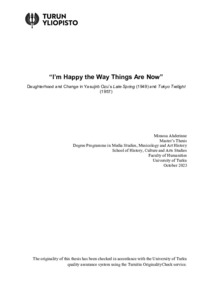“I’m Happy the Way Things Are Now” : Daughterhood and Change in Yasujirō Ozu’s Late Spring (1949) and Tokyo Twilight (1957)
Ahderinne, Mimosa (2023-11-01)
“I’m Happy the Way Things Are Now” : Daughterhood and Change in Yasujirō Ozu’s Late Spring (1949) and Tokyo Twilight (1957)
Ahderinne, Mimosa
(01.11.2023)
Julkaisu on tekijänoikeussäännösten alainen. Teosta voi lukea ja tulostaa henkilökohtaista käyttöä varten. Käyttö kaupallisiin tarkoituksiin on kielletty.
avoin
Julkaisun pysyvä osoite on:
https://urn.fi/URN:NBN:fi-fe20231208152529
https://urn.fi/URN:NBN:fi-fe20231208152529
Tiivistelmä
The career of Japanese director Yasujirō Ozu (1903–1963) is best remembered for family dramas dealing with personal stories of his contemporary times. This study focuses on the role of daughterhood, and how social change is represented through it in Ozu’s post-war films. Applying close reading as the research method, Late Spring (1949) and Tokyo Twilight (1957) have been chosen as case studies of Ozu’s post-war films.
While family is a central theme in his works, research on gender in Ozu’s films is scarce and lacks feminist approaches. The aim of the study is to widen the horizons in Ozu research by drawing attention to gender discourses prevalent in the films. Beyond film studies, attention to the role of daughterhood has not been widely studied in humanist fields. Thus, this study establishes a definition of daughterhood in Late Spring and Tokyo Twilight based on Judith Butler’s theory of gender as performance, Stuart Hall’s constructionist approach to representation and studies of Japanese family relations and expectations.
Close reading of Late Spring and Tokyo Twilight indicate discourses of daughterhood that connect it to the cultural and historical moment of post-war Japan. While there are differences between the films, together they help define daughterhood that is part of social change as a fluid identity that ties together past, present and the future, as well as contradicting presentations of gender. By implementing feminist research approach to Ozu’s films, this study highlights the potential of new perspectives and alternative readings in the field.
While family is a central theme in his works, research on gender in Ozu’s films is scarce and lacks feminist approaches. The aim of the study is to widen the horizons in Ozu research by drawing attention to gender discourses prevalent in the films. Beyond film studies, attention to the role of daughterhood has not been widely studied in humanist fields. Thus, this study establishes a definition of daughterhood in Late Spring and Tokyo Twilight based on Judith Butler’s theory of gender as performance, Stuart Hall’s constructionist approach to representation and studies of Japanese family relations and expectations.
Close reading of Late Spring and Tokyo Twilight indicate discourses of daughterhood that connect it to the cultural and historical moment of post-war Japan. While there are differences between the films, together they help define daughterhood that is part of social change as a fluid identity that ties together past, present and the future, as well as contradicting presentations of gender. By implementing feminist research approach to Ozu’s films, this study highlights the potential of new perspectives and alternative readings in the field.
